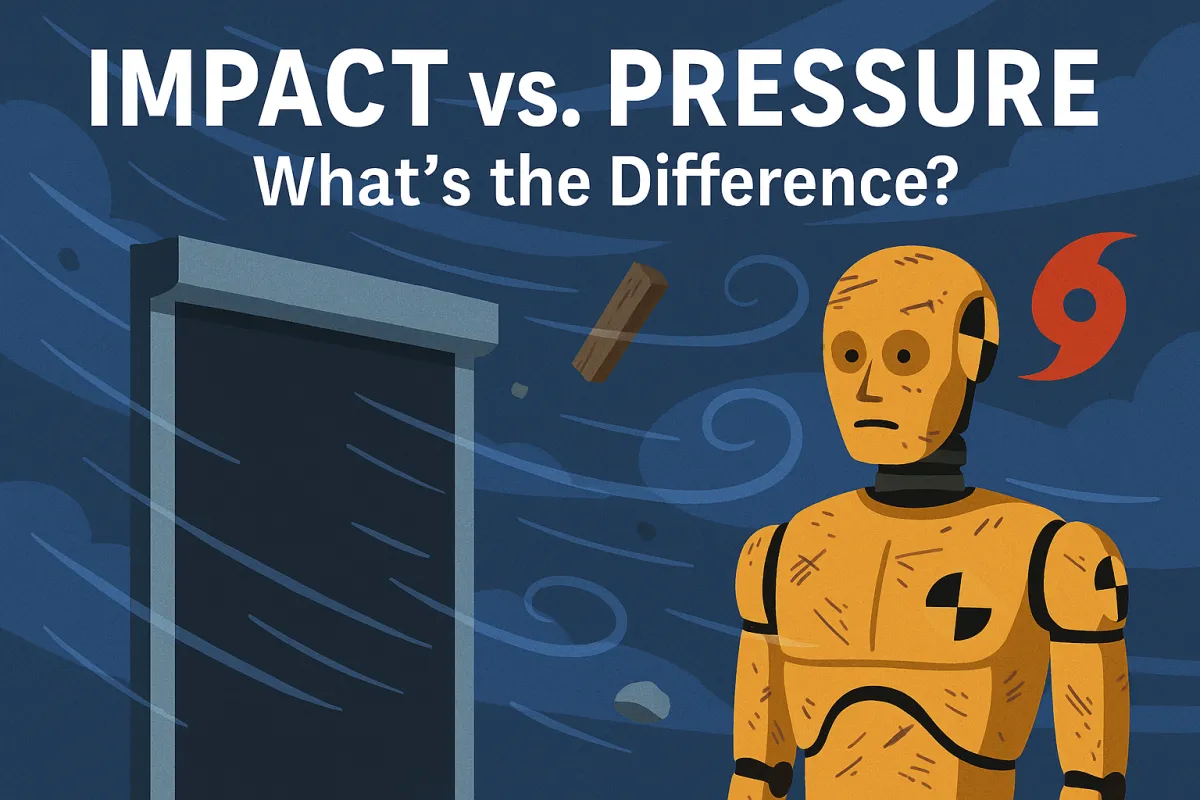
Impact vs. Pressure and Motorized Hurricane Screens
The Biggest Misconception about Motorized Hurricane Screens
It’s one of the biggest misconceptions in hurricane protection: people think if a screen can handle a flying object, it’s good to go. Or they assume if it’s rated for wind pressure, it can stop debris. The truth? Impact resistance and pressure resistance are two completely different beasts — and if your motorized screen can’t do both, your home isn’t storm-ready.
Flying Debris During A Hurricane
Let’s start with impact. When we say a screen is “impact-rated,” it means it’s been tested to take a hit from something like a 2x4 launched at 30+ miles per hour — simulating what happens when hurricane winds turn everyday objects into high-speed missiles. That’s what ASTM E1886 and TAS 201 focus on: can the screen take the punch and stay in one piece?
Here Is The Nasty Little Secrete Motorized Hurricane Screens
But here’s the thing… hurricanes don’t hit once and leave. They pull, push, shift, and slam for hours. That’s where pressure resistance comes in. Your screen doesn’t just need to survive a single blow — it has to hold up under constant, fluctuating wind loads. That’s what ASTM E330, ASTM E1886 (again), and TAS 202/203 are all about: can your screen survive the storm’s breath?
How does Impact and Pressure Affect A Motorized Screen
To picture the difference, imagine this:
💥 Impact is someone throwing a brick at your front door.
💨 Pressure is someone leaning on that door for 12 straight hours — then pulling on it… then pushing again… over and over. If your screen system can’t handle both? The storm gets in.
Here’s where it gets tricky. Some screens pass one test but not the other. A product might claim “hurricane resistance” because it passed a pressure test — but it’s never been hit with debris. Or vice versa. And as a homeowner, you might not know to ask about both.
The only way to ensure full protection is to look for certifications that cover both categories. That means:
ASTM E1886 + E1996 for impact and cycling
ASTM E330 for structural wind pressure
TAS 201, 202, and 203 if you’re in Florida (especially Miami-Dade or HVHZ zones)
The best-motorized hurricane screens — like the MagnaTrack system from Progressive Screens — and MaxForce System by Fenetex Motorized Screen — are built to pass all of it. They’re not guessing. They’re tested, certified, and trusted by builders and homeowners who can’t afford to take chances.
Know the code. Know the difference. Be storm-ready.
So before you choose a screen system based on looks, convenience, or even cost — ask the question most salespeople avoid:
“Has it been tested for both impact and pressure — and can you show me proof?”
Because one without the other? That’s just leaving the door cracked open in a Category 5 storm.

Cited & Referenced Sources for Post 4
ASTM Standards for Impact & Pressure Testing
ASTM E1886 – Standard Test Method for Performance of Exterior Windows, Curtain Walls, Doors, and Impact Protective Systems Impacted by Missile(s) and Exposed to Cyclic Pressure Differentials
🔗 https://www.astm.org/Standards/E1886.htm
Describes the combined impact and cyclic pressure testing method for hurricane protection products.
ASTM E1996 – Specification for Performance of Exterior Windows, Curtain Walls, Doors, and Impact Protective Systems Impacted by Windborne Debris
🔗 https://www.astm.org/Standards/E1996.htm
Outlines impact classification levels (A–E) and missile test types for product categorization.
ASTM E330 – Standard Test Method for Structural Performance by Uniform Static Air Pressure
🔗 https://www.astm.org/Standards/E330.htm
Evaluates the structural performance of exterior systems under uniform wind pressure.
Florida & Miami-Dade Testing Standards
TAS 201 – Impact Test Procedures
🔗 https://www.miamidade.gov/building/library/design-guidelines/testrptreq.pdf
Details the large and small missile impact testing procedures required in HVHZ regions.
TAS 202 – Uniform Static Air Pressure Test
🔗 [https://www.miamidade.gov/building/library/design-guidelines/testrptreq.pdf]
— Describes the wind pressure test conducted under sustained load conditions.
TAS 203 – Cyclic Wind Pressure Loading
🔗 [https://www.miamidade.gov/building/library/design-guidelines/testrptreq.pdf]
— Tests product resilience under repeated push/pull forces simulating hurricane gusts.
Florida Product Approval Portal
🔗 https://www.floridabuilding.org/pr/pr_app_srch.aspx
Official tool to search for Florida-approved storm-rated products.
Manufacturer & Third-Party Testing Reference
Progressive Screens – MagnaTrack System Overview
🔗 https://progressivescreens.com/
Manufacturer of motorized hurricane screens tested to meet ASTM and TAS standards.
Intertek – Hurricane and Windborne Debris Testing
🔗 https://www.intertek.com/building/hurricane-impact/
Third-party testing lab that performs ASTM and TAS certification for building components.
